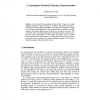Free Online Productivity Tools
i2Speak
i2Symbol
i2OCR
iTex2Img
iWeb2Print
iWeb2Shot
i2Type
iPdf2Split
iPdf2Merge
i2Bopomofo
i2Arabic
i2Style
i2Image
i2PDF
iLatex2Rtf
Sci2ools
87
Voted
DGCI
1999
Springer
1999
Springer
A Topological Method of Surface Representation
A new method of representing a surface in the 3D space as a single digitally continuous sequence of faces is described. The method is based on topological properties of quasi-manifolds. It is realized as tracing the boundary of a growing set of labeled faces. As the result the surface is encoded as a single sequence of mutually adjacent faces. Each face is encoded by one byte. The code of the surface of a three-dimensional object takes much less memory space then the raster representation of the object. The object may be exactly reconstructed from the code. Surfaces of a genus greater that zero (e.g. that of a torus) may also be encoded by a single continuous sequence. The traversal algorithm recognizes the genus of the surface.
Related Content
| Added | 04 Aug 2010 |
| Updated | 04 Aug 2010 |
| Type | Conference |
| Year | 1999 |
| Where | DGCI |
| Authors | Vladimir Kovalevsky |
Comments (0)

